Most, if not all of us are familiar with the tale of Sleeping Beauty, whether our parents read it to us as a child or we saw the iconic Disney movie. In Maleficent, Director Robert Stromberg has taken this well-loved story and completely turned it on its’ head. I was quite pleased to see his repurposing of the tale transform what was a story of male heroism and bravery into a celebration of female empowerment. This, of course, flips much of the traditional symbolism of the tale upside down. Stromberg does this with purpose and clever writing.
RELATED Behind the Grimm: A Very Tangled Journey
In Very Aware Magazine, Director Robert Stromberg admits in an interview his desire to focus on the darker side of the fairytale in comparison to the more lighthearted approach the original Disney film took. He says, “Looking back on them (Disney fairy tales), they’re pretty dark – there are some tragic things going on there. We always remember the fluffy side to them. When you look at this film, it has the tragic side of things. The cocktail of what made those successful is struggling through the dark sides of things to find the light. That’s what we try to do here.”
Maleficent focuses on the iconic villain’s side of the story. Her backstory is fleshed out for the audience, giving us a peek into her world. Right off the bat, Robert Stromberg claims he was strongly drawn to the idea of having Maleficent be a strong female character. In an interview he stated,
“She is a superhero in her own right, but the strength of being a female and how to stay strong yet find the softer emotional attachment, it was really an interesting conundrum.”
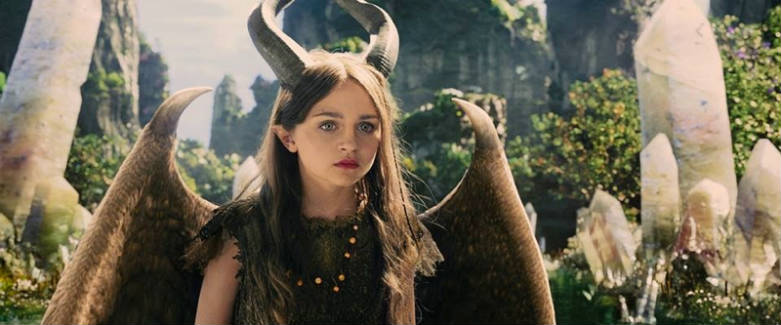
The story begins with the innocent and kind fairy, Maleficent living in a kingdom called The Moors, which is at constant odds with it’s neighboring human kingdom. As a young girl, Maleficent meets a human boy, Stefan, who was caught stealing from the fairies. She saves him from the wrath of the fairies by convincing him to return the jewel that he had stolen. The two end up forming a close friendship, which eventually turns into love on the part of Maleficent. Stefan even gives her what he claims is “true loves kiss” when she turns sixteen.

The film sets us up with a view of Maleficent as a character not unlike most other young girls maturing into adulthood, from having childhood friendships to exploring their attraction to the opposite sex. Stromberg gives us a very human Maleficent, whom we can relate to and empathize with. With this simple change, Stromberg is already separating himself from the traditional fairy tale. In typical folklore, fairies remain unconcerned with the lives of humans, caring solely about themselves and their own importance. Maleficent’s befriending of Stefan and exhibiting human traits such as a belief in love, sets her far apart from the traditional fairy.
It is when Angelina Jolie takes over as the beautiful and feisty Maleficent that we really start to get into the emotional struggles she will go through throughout the film. I have to point out that this role could not have been better cast. Angelina Jolie was born for this role and performs it beautifully. She clearly fully immersed herself in the part and all of it’s complexities, which shines through in her performance. As Stromberg comments,
“What I was pleasantly surprised with was the depth of emotion of the character that she had been preparing for a long time to bring that to this iconic image.”
As the first blissfully happy chapter of the story ends, we then embark on Maleficent’s journey to the dark side. As Stefan grows older, he strays from Maleficent and ends up brutally betraying her in an effort to become the new king of the humans. At this point, Stromberg sets up Stefan as a kind of villain, although we don’t yet know just how evil he may become, or who the real villain of the story will end up being. He certainly reveals himself to be an oppressive male figure. In an attempt to gain the throne, Stefan brutally cuts off Maleficent’s wings while she is in a drugged sleep and brings them back to his king as a trophy of his supposed kill. By taking Maleficent’s wings, a symbol of her absolute freedom, he thereby confines her to walk on land, symbolically shackling her. This meaning is especially evident when just before this the audience was shown Maleficent flying freely above the clouds, a look of exhilaration on her face. This is the first instance in which this man forcefully limits the freedom of one of the female characters.
This act sparks the dark feelings in Maleficent, which lead her to become the evil persona we are all familiar with from the Disney film. We quickly see her spiral into the dark abyss of hatred that pushes her towards her enacting revenge upon now King Stefan. It’s then the character of Diaval is introduced, her raven assistant who acts as the wings she recently lost, spying upon the man she hates.

In Diaval we see another change made to the traditional story. Stromberg gives this Maleficent a helper figure, traditionally known as a donor in fairy tales, similar to the figure of Jiminy Cricket in Pinocchio. While the Maleficent in the animated Disney version also has the assistance of her raven figure, he does not perform the types of services that a donor does. This raven helper, Diaval, serves not only as Maleficent’s eyes and ears abroad but also as her conscience, as we will see in later scenes. He is a benevolent and kind character that helps to revive Maleficent’s good side in the second half of the film. Interestingly, this type of character is typically paired up with the hero of a fairy tale and assists the hero in completing his quest and defeating the villain. So, we see Stromberg giving Maleficent more and more traits that a typical hero would have, changing her from the wicked fairy godmother figure into the heroine we will see her become as the story progresses. Diaval is also an ever-faithful figure, staying true to the hero even when the hero doesn’t listen to his or her advice. This is also true with Diaval, as he doesn’t always agree with the more evil acts the Maleficent performs, but continues to stay by her side and help slowly bring out the good in her.
In an effort to punish Stefan, the sins of the father are visited upon the daughter, Aurora, in the form of the powerful sleeping curse. The christening scene is one of the most important, if not the most important, scenes in the film. For Stromberg this was paramount.
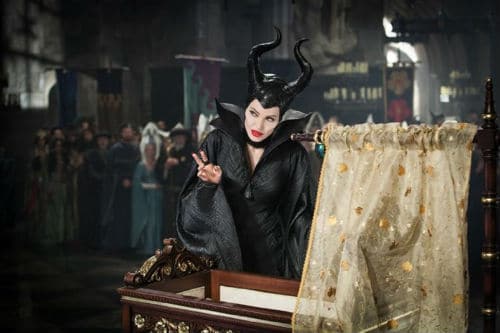
The christening scene is the center of point of the movie.
“The christening scene is the center of point of the movie. We filmed it almost verbatim – word for word – from the classic animated film…It was critical they can see this iconic character they loved in all her glory, but now they have an understanding why she became that and who she was.”
Speaking once again to the idea of the traditional role and personality of the fairy in folklore, I think that this scene and Stromberg’s intentions with the character of Maleficent definitely set it apart from the original fairy tale, and mark Stromberg’s purposeful choice to deviate from not necessarily the details of the scene, but from the purpose and significance behind it. He has now presented us with a fully realized and humanized fairy character. In general, fairies are concerned with only themselves and changing sides on a whim. They will curse and bless characters in fairy tales with equal gusto depending on their mood. In the written fairy tale of Sleeping Beauty, both in the Perrault version and the Grimm’s version, the fairy curses the baby because of a simple slight. She is insulted that she was not invited to the christening, and decides to take revenge. It reminds me of the ever-changing whim of the gods in mythology. Something as simple as a forgotten invitation can incur the greatest wrath.
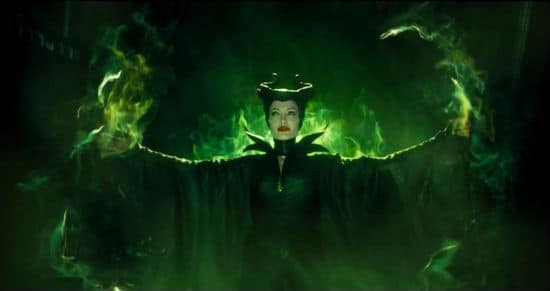
Stromberg completely changes this aspect of the fairy tale by not only giving Maleficent a back story but by also giving her human feelings. Her reasons for enacting this revenge go far deeper than a simple slight or insult. She is deeply hurt and angry and wants to hurt the man who stole her heart as much as he hurt her. The scene also makes it clear that she is reveling in her dark side. She fully enjoys herself at the expense of King Stefan when she places the curse on Aurora. She plays it up and keeps pushing to see how far she can get King Stefan to crumble. This is a betrayed woman enacting what is probably in some sense every betrayed woman’s fantasy. I can totally relate. Maleficent isn’t some simple fairy. She has become a fully realized character, who draws our sympathy and feelings just as much as the other lead characters, perhaps more in the case of this film. And this was precisely Stromberg’s goal.
“We wanted to escape from this one-dimensional character which you can argue the character is in the classic telling of this. Her character goes through so many emotions, but we wanted her character to be dark but explore how to have fun with evil and then to have redemption, regret, and other emotions.”
After the christening, Aurora is sent to live with the three rather bumbling and completely inept fairies that presented the other gifts she received. It is through the juxtaposition of their poor care of Aurora in contrast with the secret care she receives from Maleficent that we start to see a change occur in Maleficent. Jolie puts Maleficent’s emotional struggle and gradual change from the evil fairy to something different into perspective perfectly when she explains,
We feel a little darker. We feel we’ve been hurt, wounded, upset –
“I think it’s kind of this idea of something we can all relate to, where we’ve gotten to a place in our lives where we feel a little hardened by life. We feel a little darker. We feel we’ve been hurt, wounded, upset – whatever it may be that’s turned us where we don’t trust. We’ve all got it. And then there’s something that enters your life – whether it be love or children or something that we just discover – that just kind of opens you up again and takes you a while to identify or understand what’s happening inside or you, especially for Maleficent.”
As Aurora grows up, we see her essentially become a pawn in the fight between the two arch-rivals, Maleficent, and King Stefan. What sets the tone in the film, however, is the difference in each rivals’ relationship with and use of the young innocent Aurora. From the first moment Aurora is placed with the three fairies, we see Maleficent begin to bend and change. She sends Diaval to feed her in the middle of the night when the fairies simply place carrots on top of her when she’s crying in hunger the first day they are trying to care for her. When she almost walks off a cliff playing as a small child and the other fairies are not watching her, Maleficent saves her by having a tree limb catch her and place her back on land. She watches Aurora in secret, protecting her and nurturing her as she grows. While at first it seems to come from a place of curiosity, it slowly changes into an almost maternal role. She slowly takes the place as the good fairy godmother that the other three fairies were originally meant to inhabit.
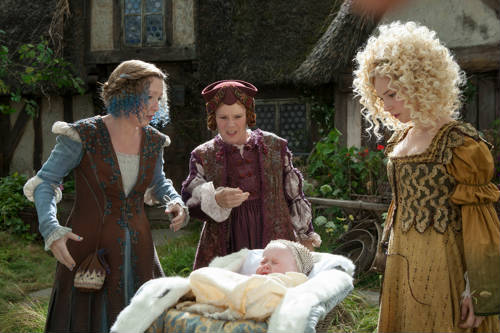
Traditionally, fairy godmothers in fairy tales are not portrayed as typical fairies from folklore. They act in a manner atypical of fairies in actual folklore belief, who, as I explained before, are preoccupied with the character and fortunes of humans rather than the actual humans themselves. They look out for themselves first and foremost, and humans are only interacted with if they might prove useful to that fairy. Fairy godmothers, on the other hand, are portrayed as being just like godmothers in real human society, and take on human traits rather than fairy ones. They exert their benefits for their godchildren, acting as a mentor and guide through whatever trials their godchildren are confronted with. They were like a second set of parents for that child.
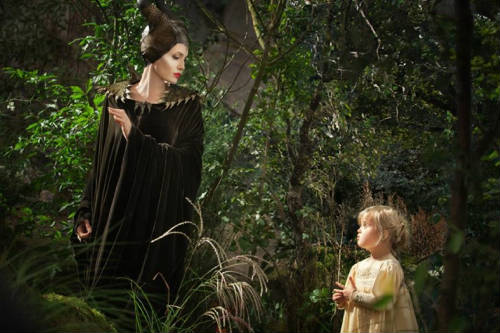
In Maleficent, we see Maleficent literally taking over that role and changing from a wicked fairy godmother, a character only actually seen in this particular tale, into a good fairy godmother. It is certainly not an overnight change or an easy one for Maleficent. One scene that portrays this in a very touching way is when Aurora comes upon Maleficent when she is a small child. Angelina does a beautiful job portraying the awkwardness Maleficent feels around this human child. But Aurora, being the curious thing she is, approaches Maleficent and reaches her arms up, asking to be picked up. Maleficent, after unsuccessfully claiming that she doesn’t like children, very awkwardly does this, and I don’t think there was a dry eye in the room when the adorable Aurora reached up and explored Maleficent’s face and horns. You can see Maleficent being slowly and unwillingly charmed by the child. And yet, when she puts her down she can’t help but end the encounter with a shooing motion, trying to act as if the child is some kind of dirty stray dog she wants to be gone from her presence.
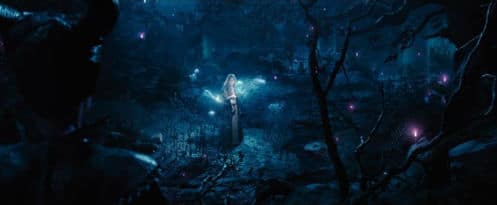
When Aurora grows into her teens she becomes fascinated with the idea of the fairy kingdom, venturing up to the wall surrounding it and trying to find a way through. Maleficent, giving in once again to the desires of the girl, brings her safely through the wall of thorns into the fairy kingdom. This marks a period of momentous change in Maleficent. As she continues to meet with Aurora in the fairy kingdom and watch over her, we see her feelings for the girl grow in strength, and her role as her fairy godmother is sealed. Aurora even states the fact to Maleficent, revealing that she remembers Maleficent’s presence in her life as she was growing up. Surprisingly, we receive no argument against this title from Maleficent. Maleficent even attempts to lift the curse from Aurora to no avail. Stromberg has officially changed the role of this character.
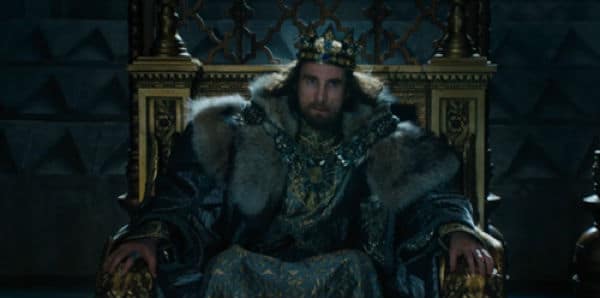
From this point on we really see the theme of female empowerment build and shine throughout the rest of the film. As Maleficent has been going through this total change in character, King Stefan has been preparing obsessively for the day when Aurora arrives at the castle and the curse is supposed to be enacted. Knowing that iron harms fairies, he has placed a wall of iron thorns, similar to the wall of thorns created by Maleficent to protect the fairy realm as well as the wall of thorns she created as an obstacle to the prince in the Disney film, around and inside the castle, barring entry from Aurora’s chambers. When Aurora discovers that Maleficent placed the curse on her she runs immediately to the castle and her father, expecting a warm reunion. However, upon her arrival she is locked inside her royal chambers after barely saying hello to her father who hasn’t seen her for sixteen years. He is much more obsessed with his rivalry with Maleficent than he is with Aurora. He treats her as simply another pawn to be controlled in their game.
In Perrault’s Sleeping Beauty, the prick of the spinning wheel is seen as a means to restrain the heroine’s unseemly curiosity and female unruliness. While many see this heroine as a passive female figure, they fail to recognize the adventurous and curious woman in her, who, when left to her own devices, goes off on her own to explore this foreign castle. When she then finds something new, she seeks to explore it and see just what it is. These are hardly the actions of a completely passive and obedient female. And so, these wanderings and signs of independence are punished.
While it is the fairy’s curse that punishes Aurora in Perrault’s fairy tale, I would argue that Stromberg transfers the blame to King Stefan, relieving that burden from Maleficent.
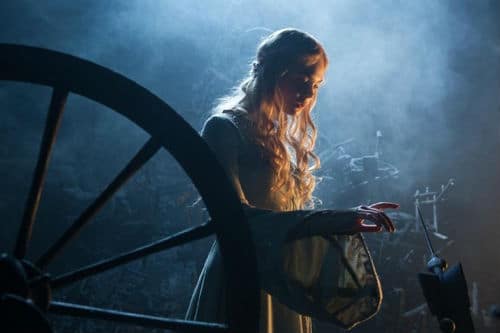
Let’s first consider the idea of who encourages and who stifles Aurora’s independent nature. First, we see Aurora’s independence in arriving early to her father’s castle punished by her being immediately locked in her room. When she escapes and explores the castle as the original character does, she then comes upon the room where for some reason all of burned the spinning wheels were kept (you’d think he’d have gotten rid of those), pricks her finger upon the spindle of one of the spinning wheels, and falls into the cursed sleep. The minute Aurora is within King Stefan’s sphere of influence, he tries to snuff out her natural curiosity and adventurous spirit by locking her up.
Maleficent, on the other hand, has been nurturing Aurora’s adventurous nature her entire life. She encourages her to explore the fairy kingdom and the world around her. She invites Aurora into a land from which she has barred all others. This shows her complete trust in and approval of Aurora’s natural curiosity and fiery spirit.
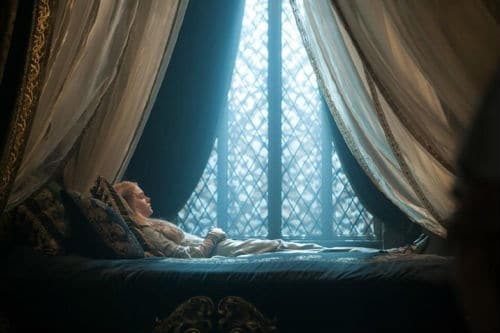
After Aurora has fallen into the cursed sleep, her father then ceremonially seals her within the palace and places her on her bed as if putting her on display. The same is done in Perrault’s tale, drawing attention to her now properly passive state and contained sensuality. As I mentioned before, King Stefan has also sealed Aurora within that castle with a wall of iron thorns. In the version by Perrault, this is done by the wicked fairy and is meant to keep any potential prince’s out. In the film, not only is the wall of thorns created by the father, but it is not meant to keep any princes out, but rather the female presence of Maleficent. This is particularly clear since the wall of thorns is made out of iron, harmful only to the fey. So, here we have the dominant male trying to desperately keep the powerful and independent female figure of Maleficent away from the now passive Aurora.
“docile beauties who are consequently transformed into ‘spectacle,’ enchanting pictures for pleasurable viewing.”
In the traditional fairy tale, the princess is only allowed to come to life when she is under the control of the male figure. This is often interpreted as the male figure being a rational influence on the female, otherwise out of control with curiosity and sensuality. They can now fulfill their role as passive wives who are meant to listen and not be heard. These female figures now on display serve as “docile beauties who are consequently transformed into ‘spectacle,’ enchanting pictures for pleasurable viewing.”
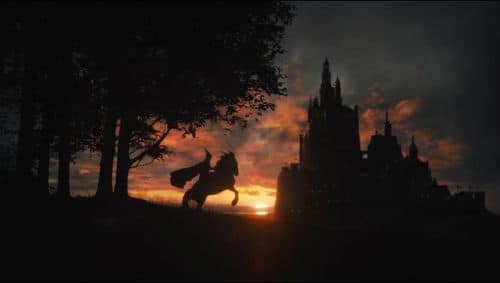
Stromberg completely turns this idea on its’ head by championing the adventurous and strong female. When Maleficent senses that the curse has fallen, she immediately goes into superhero mode, finding Prince Phillip and bringing him to the castle. Maleficent is both literally and figuratively playing the hero now as she rides in on the sleek black horse that she has turned Diaval into. There is even a moment when he rears up in the light of the setting sun, presenting Maleficent in the traditional pose of the hero racing in on his noble steed to save the princess. Stromberg does not pull any punches in this epic ending.
In another moment of juxtaposition with the original tale as well as the Disney version, we then see Maleficent making her way through the deadly wall of thorns on her way to save Aurora. To top off this re-imagining of the traditional savior, Prince Phillip is unable to awaken Aurora. It is only after Maleficent has placed a kiss upon her brow that the princess awakens. This scene in which Maleficent is clearly designated as the hero of this tale is followed by a final epic action scene where she soundly defeats King Stefan, the symbol of male oppression. Stromberg completes his theme of female empowerment by having Maleficent unite the two kingdoms and name Aurora the ruler, rather than having the male consort Prince Phillip become King as the male half of the royal couple.
As you can see, Stromberg certainly went all out when he decided to focus upon the theme of female empowerment and take a new look at the figure of Maleficent. He completely turned the tale and it’s original symbolism and message on its’ head. I for one think he did a truly amazing job and give this film a big two thumbs up. I also think Angelina Jolie in particular and Elle Fanning deserve extra special recognition. So, there you have it folks, girl power at it’s finest!
What did you think of this live action re-imagining of one of this beloved fairy tale? Sound off below…
Sources:
Courtney Howard. “Interview: Director Robert Stromberg Talks Effects, Female Empowerment and Maleficent.” Very Aware. May 26, 2014.
Tim Hayne. “Angelina Jolie on What Scares Maleficent, Breaking Character, and Acting as a Family Business.” Movie Fone. May 22, 2014.
Jacob and Wilhelm Grimm. The Annotated Brothers Grimm. Ed. By Maria Tatar.
Ed. By Jack Zipes. The Great Fairy Tale Tradition: From Straparola and Basile to the Brothers Grimm.
ARE YOU A ROMANCE FAN? FOLLOW THE SILVER PETTICOAT REVIEW:
 Our romance-themed entertainment site is on a mission to help you find the best period dramas, romance movies, TV shows, and books. Other topics include Jane Austen, Classic Hollywood, TV Couples, Fairy Tales, Romantic Living, Romanticism, and more. We’re damsels not in distress fighting for the all-new optimistic Romantic Revolution. Join us and subscribe. For more information, see our About, Old-Fashioned Romance 101, Modern Romanticism 101, and Romantic Living 101.
Our romance-themed entertainment site is on a mission to help you find the best period dramas, romance movies, TV shows, and books. Other topics include Jane Austen, Classic Hollywood, TV Couples, Fairy Tales, Romantic Living, Romanticism, and more. We’re damsels not in distress fighting for the all-new optimistic Romantic Revolution. Join us and subscribe. For more information, see our About, Old-Fashioned Romance 101, Modern Romanticism 101, and Romantic Living 101.

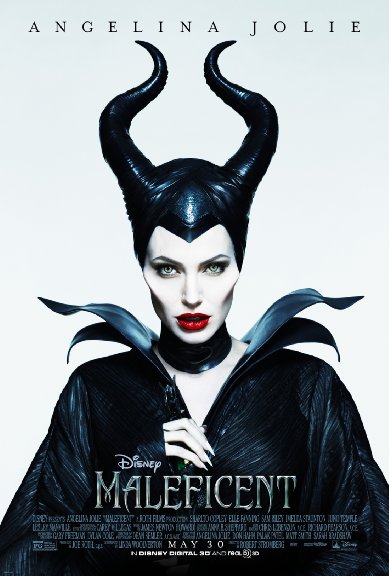
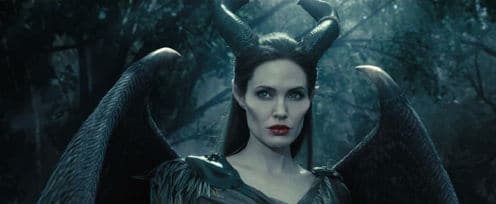
Great review! I saw Maleficent today and I completely loved it. I had high expectations anyway, but the film was even better than I expected. Angelina Jolie was wonderful (as she is in everything!) – suzannecamfield.wordpress.com
I’m do glad you enjoyed it!! It’s one of my favorite fairy tales, and I absolutely loved this version of it. It was cleverly done, and whether he meant to experiment with the fairy tale in the way he did (the specific parts not just the feminine perspective), I came away from the experience thoroughly impressed. And I totally agree with you about Angelina, she was just spectacular!
When I saw the trailer for this, I thought to myself – Rebecca Lane totally preempted this genre of repurposing fairy tales! I remember you writing these at SLC:)
Hi!!! Thank you! I’m working on one right now to get published, so here’s hoping! I remember you simply being awesome! 🙂